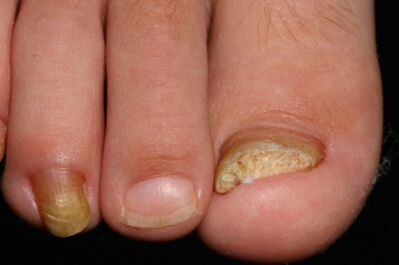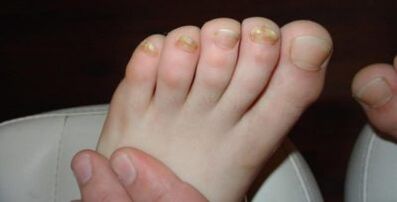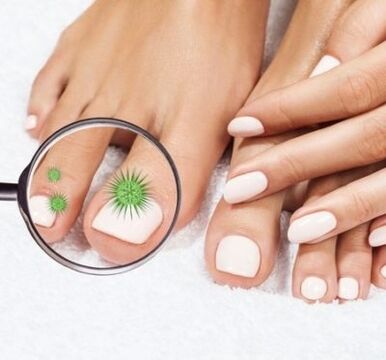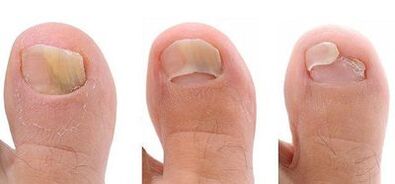Failure mycosis is an infection that is accompanied by cosmetic defect and a number of clinical symptoms.Pathological changes refer to the layer of skin and nail layers.The causative agent of Mycoses are representatives of a smaller -class fungus.The infectious process is dangerous not only for the patient himself, but also to the relatives around him.How to prevent mycosis of the nails and get rid of the infection.
Mycosis of the toenails - what is it?
The legs of the legs are called onychomycosis and refers to a special classification of diseases.Recently, complaints of the infection have increased several times.Doctors associate this indicator with unhealthy ecology.

Onychomycosis is a disease in which the structure of the nails and the epidermal layer is impaired.The surrounding tissues (skin roller) are involved in the pathological process.The nail is arranged in such a way that the cells are tightly pressed against each other, forming a thick surface.Under the nails are placed a matrix and blood vessels surrounding the bone phalanx.The upper layer is represented by hyponichia, and at the base of the nail is an eponichia.With mycosis of the nail, the pathogen affects the lower layers of the nail to the matrix.At the same time, the dividing cells destroy keratocytes and the nail plate becomes thin and brittle.Onychomycosis in the absence of treatment is accompanied by various complications and is difficult to convey to modern therapy.
Just over 50 types of fungal infections are known that are dangerous to humans.They all have different morphological characteristics and parasitic stages.In order to finally identify the pathogen, a mandatory microscopic examination is performed.
The toenails are needed to protect the soft parts of the toes from injury.Fashionistas draws nails in different colors, so mycosis is also considered a cosmetic defect.With onychomycosis, the appearance of the nail becomes worse.Nail plates burst, break and completely destroy.The disease causes exacerbation of chronic systemic pathologies.
After penetrating the nail layer, the causative agent begins to actively share, releasing new and new threads of mycelius.Due to air deficiency, mycelium is applied to healthy nail and skin areas.The disease should be diagnosed and treated.
Type
Several types of pathogen are distinguished that affect the legs on the legs.Classify parasites according to morphological characteristics and clinical signs.
- Trichophyte is red - a fungus that has branching and disputes about the threads of mycelium.The localization of the process falls on the epidermis, the gross (keratinized) parts of the cells.A specific characteristic of the damage to the red trichophitone is the rigor of the tissues.Light spots and stripes are different and then merge.In the thickness of the skin cells, mycelium is compacted, stretched and forms disputes that can withstand methods for different treatment.When coloring the nail drug in a microscope, the trichophyton structure is clearly visible.
- The epidermophyte has a cologne flap -micro -organism that causes mycosis of the toenails in the form of skin peeling, itching of interval space and stratification of the nail.Unlike Trichophyton, Epidermophyton grows in several directions of its spore cell so that the process of the process is smeared.Mycelium with different thicknesses: from delicate thin to wide and short.When studying a microscopic drug, spores and part of the mycelium are compared to flakes.The infection of the epidermophyte is accompanied by a change in the pigmentation of the nail and its gradual destruction.The infectious process begins from both the edge of the nails and its base.In addition to the yellowing of the nails of patients, increased dryness and rapid keratinization are worried.
- Mentagrofitest is one of the bright representatives of Trichophyton.It is more common, affecting the skin of the legs, the rollers of the toenails and the nails itself.The causative agent penetrates the lower layers and is able to reach the submarine epidermis - a matrix.Causes a stratum seal and the rough parts of the nail.Statistics show that almost 20 % of the fungal infection falls on Trichophyton Mentagrofitest, 80 % is the trichophyte section.Onychomycosis caused by mentagrophytes contributes to the development of allergies, the formation of vesicles and bubbles of the affected epidermis.
- The trichophytic rubler is a stable microorganism to external factors, but more often affects the skin of the feet.The causative agent has been in the patient's shoes and socks for a long time.In most cases, it occurs with other onychomycosis representatives.
- The yeast microorganisms are most famous as a candidate.Candidiasis is located on nails, skin and mucous membranes.With nail mycosis, candidates cause specific symptoms and different degrees of destruction of cane.After research, scientists have come to the conclusion that the candidate rarely becomes the main cause of mycosis, but against the background of a decrease in local immunity, the fungus is introduced into the nail microtraum and "dissolves" disputes.The fungus of the fungus is long, thin, branched.A microscopic enlargement detects a meal of mycelium and a lot of disputes.Onychomycosis caused by Candida is accompanied by wound formation, change in shape and color of the nail.Candida's parapsylosis is one of the species of candidiasis.A remarkable characteristic of the disease is the main formation of a dark spot on the surface of the nail.In the future, the place increases - the nail becomes fragile and moves away from the matrix.
- Skopulariopsis is a more common type of nail mycosis.Like candidiasis, there are also significant differences in morphology.Black small dots appear on the surface of the nail plate.In the thickness of the nail, the formation is much wider and worse.The spread of points leads to relaxation and destruction of the nail.


The species characteristics of the pathogen contribute to the correct diagnosis of the disease.However, in order to make a definitive diagnosis, it is not enough to know the clinical characteristics of the infection.For this, the pathogen must be differentiated.
Reasons
The main cause of onychomycosis is the penetration of fungi into keratocytes or epidermis.This process arises for the following reasons:
- weakened immune system due to prolonged use of antibacterial drugs (general and topical action);
- Direct contact with infection: common household items, pools or public saunas;
- The presence of chronic diseases of the endocrine system and thyroid;
- Systemic pathologies of the veins of the limbs: thrombosis, atherosclerosis, enlargement of varicose veins, tendency to thrombophlebitis;
- herpes infection that contributes to the fall of body protection;
- gastrointestinal diseases and muscle pathologies;
- Age -related changes.

Nail mycosis can be the result of improperly selected shoes and underwear.
Pay attention!Wearing socks of synthetic quality leads to air deficiency, which creates the "soil" to spread mycoses.
Near shoes and shoes are not seasonal, the lack of leg hygiene and the use of common manicure tools often leads to onychomycosis compared to chronic diseases.
Symptoms
You may suspect nail mycosis in the presence of such signs as:
- Small itching and burning.
- Peeling of the skin and the redness of the interdigital space.
- Tightening the nail and the appearance of the surface of small dots, cracks or rigor.
- Unpleasant odor and tenderness appear with the toes (when running, walking or shoes).
The pathology develops rapidly and after a short while the patient is concerned about the fragility, relaxation and pigmentation of the plate.In the absence of treatment, a yellow-green or dark brown hue appears, a roll of hyperemia, the burning of the epidermis and the disappearance of the nail glosses.All these signs show different degrees of damage to the nail.
The degree of damage to the feet on the legs
The fungus of the toenails are classified according to the degree of intensity of clinical signs.There are only three degrees of pathology:

- Initial or normotrophic degree.The focus of the infection falls on the end fingers.The plaque has mild stratification or light pigmentation.
- Hypertrophic degree is characterized by the development of clinical signs.Patients note soreness, increased sweating and the presence of an unpleasant odor.The nail is compacted and colorful.
- Atrophic degree is the most dangerous form of pathology, since all layers of nails and matrix are involved in the pathological process.Atrophic changes are captured by the nearby parts of the skin and roller.Due to the significant destruction, the risk of bacterial infection and the development of purulent processes increase.Treatment processing can lead to sepsis or bacteria.
The type of malaise is extremely important for a doctor as it allows you to determine the treatment method and prevent complications.
Diagnostics
Diagnosis or mycologists are involved in diagnosis as well as the treatment of the disease.To confirm the diagnosis, special studies are conducted:
- Microscopic examination of part of the nails or scraping;
- Sowing for food environments for pathogen growth and selection of therapy;
- Histological examination of the skin of the skin to evaluate the severity.
The doctor conducts an external examination, collects the patient's history and his / her complaints.If necessary, it recommends doing a common blood test.
Diagnostic manipulations take some time, as part of the nail is placed in special solutions to dissolve cellular elements and study pathogen morphology.It is impossible to diagnose only by external signs, we can only take a pathogenic pathogen.
After a thorough diagnosis and evaluation of the severity of the disease, the treatment method is determined.
Treatment of mycosis of the toenails
The treatment of mycosis of the toenails depends on the condition of the patient and the degree of nail destruction.The main goal for the treatment of nail mycosis is to complete the patient from the pathogen and the constant relapse.Treatment tactics and the method of therapy are determined by the doctor.
Medication

The most common method of treatment is the use of medicines.The following groups of pharmaceutical products are used in therapy:
- Paulins are tablets that destroy the DNA of the parasite and its mycelium.It is recommended that you receive funds for at least 14 days.
- Azoles are medicines that inhibit the growth of pathogenic agents and prevent their reproduction.
- Allamines are long -acting drugs used in advanced stages.Due to the minimum contraindications, medicines are successful.
The above medicines have several dosage forms: tablets, capsules, creams and sprays.Antifungal drug therapy is performed both inside and outside.The course of treatment is determined by the doctor.In addition to specific agents, antiseptic solutions for washing, antibiotics and wound healing are prescribed.Doctors advise gradually getting rid of the affected dish: cut or cut the edges, use a special patch.
Surgery
If conservative treatment does not produce positive results, then they resort to surgery.The intervention is performed with the help of laser rays to suppress the growth of pathogenic microflora.The procedure is performed in several stages.
Traditional medicine
Non -traditional recipes are used to rinse wounds and increase local immunity.It is impossible to eliminate the fungus with folk methods, but it is possible to weaken the pathogen of mycosis.
- The most famous and common method is bathrooms and compresses with tar soap.
- Famous baths with sodium bicarbonate and salt - eliminate bacteria and exercise antiseptic properties.
- Lemon juice and propolis.The nail is lubricated with juice and the compress is made from propolis.
- Salandin juice and vinegar diluted with water.
- Iodine lotions.

However, folk methods are used in conjunction with medication treatment to prevent complications, non -traditional methods of treating a doctor should be coordinated.
Prevention
Preventive measures can avoid the infection and reduce the risk of recurrence of the disease.The patient should eat properly, monitor foot hygiene, do not put on someone's shoes, or use a simple cloth.When visiting saunas or pools, put on personal rubber slippers and rinse them carefully at home.
Mycosis of the toenails is an unpleasant and dangerous disease.The infection can penetrate into more deep layers and impress the nails and matrix.It is easier to prevent the disease than to cure, but when infected, the patient should seek as soon as possible for qualified help.Special creams, varnishes and tablets allow you to stop the growth of mycelium and destroy the cell wall.It is important to understand that the treatment is long, so you have to wait for the therapeutic effect not earlier than 3 weeks.























